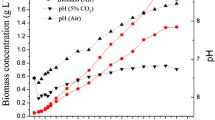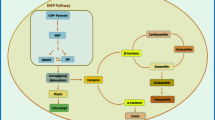Abstract
The fast growing unicellular green microalgae Chlorella protothecoides has attracted interest as a promising organism for commercial production of a high-value carotenoid, lutein, by heterotrophic fermentation. Effects of two oxidant-forming reactive oxygen species (ROS) on the biomass concentration, and yield and content of lutein in batch culture of heterotrophic Chlorella protothecoides were investigated in this study. The addition of 0.1 mmol/L H2O2 and 0.01 mmol/L NaClO plus 0.5 mmol/L Fe2+ to the culture led to the generation of ·OH and enhanced the lutein content from 1.75 to 1.90 and 1.95 mg/g, respectively. The lutein content further increased to 1.98 mg/g when 0.01 mmol/L H2O2 and 0.5 mmol/L NaClO were added to generate 1O2. The maximum yield of lutein (28.5, 29.8 and 31.4 mg/L) and a high biomass concentration (15.0, 15.3 and 15.9 g/L) were also achieved through the above treatments. The results indicated that 1O2 could promote lutein formation and enhance lutein production in heterotrophic Chlorella protothecoides. Moreover, 1O2 produced from the reaction of H2O2 and NaClO was more effective in enhancing lutein production and reducing biomass loss than ·OH from the reaction of H2O2 or NaClO plus Fe2+.
Similar content being viewed by others
References
Klaui H, In: Britton G, Goodwin T W, eds. Industrial and commercial uses of carotenoids, Carotenoid Chemistry and Biochemistry. Oxford: Pergamon Press, 1982. 309–328
Shi X M, Chen F, Yuan J P, et al. Heterotrophic production of lutein by selected Chlorella strains. J Appl Phycol, 1997, 9: 445–450, 10.1023/A:1007938215655, 1:CAS:528:DyaK1cXisFGrsLo%3D
Alexandra A R, Andrew S. The science behind lutein. Toxicol Lett, 2004, 150: 57–83, 10.1016/j.toxlet.2003.10.031
Park J S, Chew B P, Wong, T S. Dietary lutein from marigold extract inhibits mammary tumor development in BALB/c mice. J Nutr, 1998, 128: 1650–1656, 9772131, 1:CAS:528:DyaK1cXmtlKit7c%3D
Bone R I A, Landrum J T, Dixon Z. Lutein and zeaxanthin in the eyes, serum and diet of human subjects. Exp Eye Res, 2000, 71: 239–245, 10973733, 10.1006/exer.2000.0870, 1:CAS:528:DC%2BD3cXmtFGmurc%3D
Olmedilla B, Granado F, Blanco, et al. Lutein in patients with cataracts and age-related macular degeneration: a long-term supplementation study. J Sci Food Agric, 2001, 81: 904–909, 10.1002/jsfa.905, 1:CAS:528:DC%2BD3MXlt1Ght74%3D
Beatty S, Nolan J, Kavanagh H, et al. Macular pigment optical density and its relationship with serum and dietary levels of lutein and zeaxanthin. Arch Biochem Biophy, 2004, 430: 70–76, 10.1016/j.abb.2004.03.015, 1:CAS:528:DC%2BD2cXmvFeltrg%3D
Del Campo J A, Moreno J, Rodríguez H, et al. Carotenoid content of chlorophycean microalgae: factors determining lutein accumulation in Muriellopsis sp. J Biotechnol, 2000, 76:51–59, 10784296, 10.1016/S0168-1656(99)00178-9
Del Campo J A, Rodríguez H, Moreno J, et al. Lutein production by Muriellopsis sp. in an outdoor tubular photobioreactor. J Biotechnol, 2001, 85:289–295, 11173095, 10.1016/S0168-1656(00)00380-1
Del Campo J A, Rodríguez H, Moreno J, et al. Accumulation of astaxanthin and lutein in Chlorella zofingiensis (Chlorophyta). Appl Microbiol Biotechnol, 2004, 64: 848–854, 14689249, 10.1007/s00253-003-1510-5
Raymond Y N, Chen Feng. Enhanced production of free trans-astaxanthin by oxidative stress in the cultures of the green microalga Chlorococcum sp. Process Biochem, 2001, 36: 1175–1179, 10.1016/S0032-9592(01)00157-1
Wu Z Y, Shi X M. Optimization for high-density cultivation of heterotrophic Chlorella based on a hybrid neural network model. Lett Appl Microbiol, 2007, 44, 13–18, 17209808, 10.1111/j.1472-765X.2006.02038.x, 1:CAS:528:DC%2BD2sXitlyht7o%3D
Zhang X W, Shi X M, Chen F. A kinetic model for lutein production by the green microalga Chlorella protothecoides in heterotrophic culture. J Indust Microbiol Biotechnol, 1999, 23, 503–507, 10.1038/sj.jim.2900760, 1:CAS:528:DC%2BD3cXlsFOhtw%3D%3D
Shi X M, Liu H J, Zhang X W, et al. Production of biomass and lutein by Chlorella protothecoides at various glucose concentrations in heterotrophic cultures. Process Biochemi, 1999, 34: 341–347, 10.1016/S0032-9592(98)00101-0, 1:CAS:528:DyaK1MXksVSrtbg%3D
Shi X M, Zhang X W, Chen F. Heterotrophic production of biomass and lutein by Chlorella protothecoides on various nitrogen sources. Enzyme Microb Tech, 2000, 27: 312–318, 10.1016/S0141-0229(00)00208-8, 1:CAS:528:DC%2BD3cXkslSjt7k%3D
Shi X M. High-yield production of lutein by the green microalga Chlorella protothecoides in heterotrophic fed-batch culture. Biotechnol Prog, 2002, 18: 723–727, 12153304, 10.1021/bp0101987, 1:CAS:528:DC%2BD38XltlCnsLY%3D
Shi X M, Wu Z W, Chen F. Kinetic modeling of lutein production by heterotrophic Chlorella at various pH and temperatures. Mol Nutr Food Res, 2006, 50, 763–768, 16865749, 10.1002/mnfr.200600037, 1:CAS:528:DC%2BD28XovFKrurY%3D
Orosa M, Torres E, Fidalgo P, et al. Production and analysis of secondary carotenoids in green algae. J Appl Phycol, 2000, 12: 553–556, 10.1023/A:1008173807143, 1:CAS:528:DC%2BD3cXoslejuro%3D
Park E K, Lee G C. Astaxanthin production by Haematococcus pluvialis under various light intensity and wavelength. J Microbiol Biotechnol, 2001, 11: 1024–1030, 1:CAS:528:DC%2BD38XnsVehug%3D%3D
Salguero A, de la Morena B, Vigara J, et al. Carotenoids as protective response against oxidative damage in Dunaliella bardawil. Biomol Eng, 2003, 20: 249–253, 12919805, 10.1016/S1389-0344(03)00065-0, 1:CAS:528:DC%2BD3sXmt1KhsrY%3D
Ip P F, Chen F. Employment of reactive oxygen species to enhance astaxanthin formation in Chlorella zofingiensis in heterotrophic culture. Process Biochem, 2005, 40: 3491–3496, 10.1016/j.procbio.2005.02.014, 1:CAS:528:DC%2BD2MXhtVeiurbI
Shaish A, Avron M, Pick U, et al. Are active oxygen species involved in induction of β-carotene in Dunaliella bardawil. Planta, 1993, 190: 363–368, 10.1007/BF00196965, 1:CAS:528:DyaK3sXks1Oksb0%3D
Fan L, Vonshak A, Zarka A, et al. Does astaxanthin protect Haematococcus against light damage. Natur forsch, 1998, 53: 90–93
Rise M, Cohen E, Vishkautsan M, et al. Accumulation of secondary carotenoids in Chlorella zofingiensis. J Plant Physiol, 1994, 144: 287–292, 1:CAS:528:DyaK2cXmslKqsrc%3D
Bar E, Rise M, Vishkautsan M, et al. Pigments and structural changes in Chlorella zofingiensis upon light and nitrogen stress. J Plant Physiol, 1995, 146: 527–534, 1:CAS:528:DyaK2MXnsVyhsLg%3D
Kobayashi M, Kakizono T, Nagai S. Enhanced carotenoid biosynthesis by oxidative stress in acetate-induced cyst cells of a green unicellular alga, Haematococcus. J Ferment Bioeng, 1993, 84,1: 94–99, 10.1016/S0922-338X(97)82794-8
Chen F, Johns M R. Effect of C:N ratio and aeration on fatty acid composition of heterotrophic Chlorella sorokiniana. J Appl Phycol, 1991, 3: 203–209, 10.1007/BF00003578, 1:CAS:528:DyaK38XhtVansrY%3D
Shi X M, Chen F. Production and rapid extraction of lutein and the other lipid-soluble pigments from Chlorella protothecoides grown under heterotrophic and mixotrophic conditions. Nahrung/Food, 1999, 43: 109–113, 10.1002/(SICI)1521-3803(19990301)43:2<109::AID-FOOD109>3.0.CO;2-K, 1:CAS:528:DyaK1MXmvVGmsL8%3D
Halliwell B, Gutteridge M C. Biologically relevant metal ion-dependent hydroxyl radical generation. An update. FEBS Lett, 1992, 307: 108–112, 1322323, 10.1016/0014-5793(92)80911-Y, 1:CAS:528:DyaK38Xlt1Kmt7c%3D
Cui K, Luo X L, Xu K Y, et al. Role of oxidative stress in neurodegeneration: recent developments in assay methods for oxidative stress and nutraceutical antioxidants. Prog Neuro-Psych, 2004, 28: 771–799, 10.1016/j.pnpbp.2004.05.023, 1:CAS:528:DC%2BD2cXnsFSqtLs%3D
Zhao W N, Han Y S, Saishi H. Quenching of singlet inglet oxygen arisen from NaOCl - H2O2 system by carotenoids. Acta Biophy Sin, 1997, 13: 137–142, 1:CAS:528:DyaK2sXmvVCqtL0%3D
Olinescu R, Smith T. In: Boriotti S, Denis D, Shohov T, eds. Free radicals in medicine. Oxygen Free Radicals. New York: Nova Science Publishers, 2002. 23–34
Fu W Y, Xu L H, Zhang Y Y, et al. Regulatory effect of reactive oxygen species on apoptosis induced by chemicals. Chin Pharmacol Toxicol, 2002, 16: 464–470, 1:CAS:528:DC%2BD3sXmsVarsr0%3D
Fraser P D, Miura Y, Misawa N. In vitro characteization of astaxanthin biosynthesis enzymes. J Biol Chem, 1997, 272,10: 6128–6132, 9045623, 10.1074/jbc.272.10.6278, 1:CAS:528:DyaK2sXhvVOnu78%3D
Diretto G, Tavazza R, Welsch R, et al. Metabolic engineering of potato tuber carotenoids through tuber-specific silencing of lycopene epsilon cyclase. BMC Plant Biol, 2006, 6: 13, 16800876, 10.1186/1471-2229-6-13
Author information
Authors and Affiliations
Corresponding author
Additional information
Supported by the National Key Project of Sci & Tech Supporting Programs Funded by Ministry of Science & Technology of China (Grant No. 2006BAD27B03), Sci & Tech Project of Guangzhou (Grant No. 2005Z3-E0331) and Sci & Tech Project of Guangdong (Grant No. 20052050166)
Rights and permissions
About this article
Cite this article
Wei, D., Chen, F., Chen, G. et al. Enhanced production of lutein in heterotrophic Chlorella protothecoides by oxidative stress. SCI CHINA SER C 51, 1088–1093 (2008). https://doi.org/10.1007/s11427-008-0145-2
Received:
Accepted:
Published:
Issue Date:
DOI: https://doi.org/10.1007/s11427-008-0145-2




